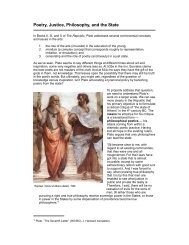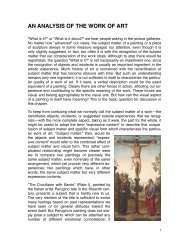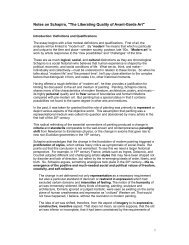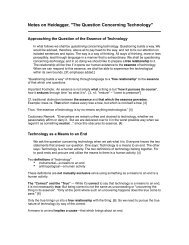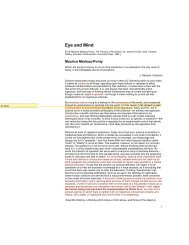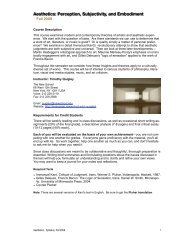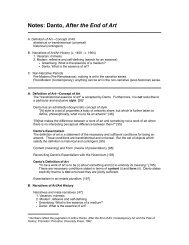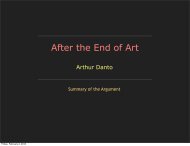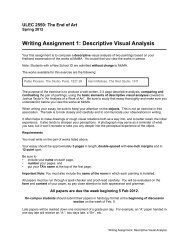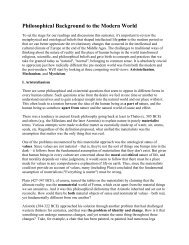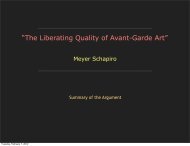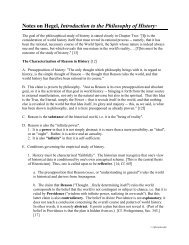The Art of Romare Bearden - Timothy R. Quigley
The Art of Romare Bearden - Timothy R. Quigley
The Art of Romare Bearden - Timothy R. Quigley
You also want an ePaper? Increase the reach of your titles
YUMPU automatically turns print PDFs into web optimized ePapers that Google loves.
<strong>The</strong> <strong>Art</strong> <strong>of</strong> <strong>Romare</strong><strong>Bearden</strong>It was as though <strong>Bearden</strong> had decided that in order to possess hisworld artistically he had to confront it not through propaganda orsentimentality, but through the finest techniques and traditions <strong>of</strong>painting. He sought to recreate his Harlem in the light <strong>of</strong> hispainter's vision, and thus he avoided the defeats suffered by many <strong>of</strong>the aspiring painters <strong>of</strong> that period who seemed to have felt that theyhad only to reproduce out <strong>of</strong> a mood <strong>of</strong> protest and despair thescenes and surfaces <strong>of</strong> Harlem, in order to win artistic mastery andaccomplish social transfiguration.It would seem that for many Negro painters even the possibility<strong>of</strong> translating Negro American experience into the modes and conventions <strong>of</strong> modern painting went unrecognized. This was, in part,the result <strong>of</strong> an agonizing fixation upon the racial mysteries andsocial realities dramatized by color, facial structure, and the texture<strong>of</strong> Negro skin and hair. And again, many aspiring artists clung withprotective compulsiveness to the myth <strong>of</strong> the Negro American'stotal alienation from the larger American culture?a culture which hehelped to create in the areas <strong>of</strong> music and literature, and where inthe area <strong>of</strong> painting he has appeared from the earliest days <strong>of</strong> thenation as a symbolic figure?and allowed the realities <strong>of</strong> their socialand political situation to determine their conception <strong>of</strong> their roleand freedom as artists.To accept this form <strong>of</strong> the myth was to accept its twin variants,one <strong>of</strong> which holds that there is a pure mainstream <strong>of</strong> American culture which is "unpolluted" by any trace <strong>of</strong> Negro American style oridiom, and the other (propagated currently by the exponents <strong>of</strong>Negritude) which holds that Western art is basically racist and thusanything more than a cursory knowledge <strong>of</strong> its techniques and history is to the Negro artist irrelevant. In other words, the NegroAmerican who aspired to the title "<strong>Art</strong>ist" was too <strong>of</strong>ten restrictedby sociological notions <strong>of</strong> racial separatism, and these appear notonly to have restricted his use <strong>of</strong> artistic freedom, but to have limitedhis curiosity as to the abundant resources made available to himby those restless and assertive agencies <strong>of</strong> the artistic imaginationwhich we call technique and conscious culture.Indeed, it has been said that these disturbing works <strong>of</strong> <strong>Bearden</strong>'s(which virtually erupted during a tranquil period <strong>of</strong> abstract painting) began quite innocently as a demonstration to a group <strong>of</strong> Negropainters. He was suggesting some <strong>of</strong> the possibilities throughwhich commonplace materials could be forced to undergo a creativemetamorphosis when manipulated by some <strong>of</strong> the non-representational techniques available to the resourceful craftsman. <strong>The</strong> stepfrom collage to projection followed naturally since <strong>Bearden</strong> hadused it during the early Forties as a means <strong>of</strong> studying the works <strong>of</strong>677



